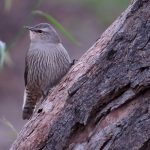WHITE-BROWED TREECREEPER
The White-browed Treecreeper is closely related to the Brown Treecreeper (Climacteris picumnus) and shares some similarities in behavior and habitat preferences. However, there are distinct differences that set the White-browed Treecreeper apart. The species is endemic to Australia and can be found in various regions across eastern and south-eastern parts of the country.The White-browed Treecreeper has a brownish-grey plumage with a noticeable white eyebrow stripe above the eye, which gives the bird its name. It has a slightly curved, slender bill, which it uses for probing crevices in tree bark for insects and other prey. The tail is relatively short and squared at the tip.
Like the Brown Treecreeper, the White-browed Treecreeper is adapted for an arboreal lifestyle. It spends most of its time on tree trunks and branches, searching for food.
Its foraging behavior involves climbing tree trunks and branches in a spiral pattern while probing the bark for insects and spiders.
These birds communicate with various calls, including high-pitched notes and whistles.
White-browed Treecreepers inhabit a range of woodland and forested habitats in eastern and southeastern Australia. They require access to suitable trees for nesting and foraging, along with dense undergrowth for cover.
White-browed Treecreepers typically nest in tree hollows or other cavities, often reusing the same nesting site for multiple breeding seasons. Both parents are involved in incubating the eggs and caring for the young.
Conservation status in NSW: Endangered Population threats due to habitat loss and fragmentation.



